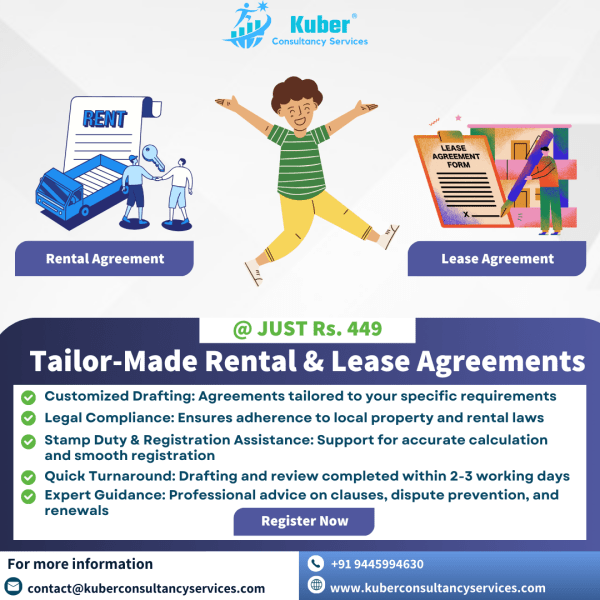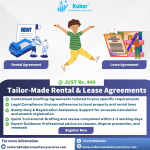Description
What Is a Rent Agreement?
A Rent Agreement is a legally binding contract between a landlord (the property owner) and a tenant (the individual who rents or leases the property). This document specifies the rights and obligations of both parties, protecting them by outlining the terms and conditions related to the property’s use, rent, security deposit, maintenance, and termination. A Rent Agreement clarifies the duration for which the tenant can stay in the property, the monthly rent, and other essential terms such as repairs, payment schedules, and responsibilities for utilities.
The Rent Agreement provides security for both the landlord and tenant by ensuring that neither party can arbitrarily change the terms of the lease or end it prematurely without following the prescribed process. It also serves as proof of the tenancy in case of legal disputes, making it a critical document for both parties.
| Why Kuber Consultancy Services for Preparing?
Kuber Consultancy Services offers expert assistance for preparing Rental and Lease Agreements because: · Experienced Professionals: Our team is well-versed in drafting legally sound agreements that protect both landlords and tenants. · Customized Solutions: We tailor agreements to meet the specific needs and requirements of the property owners and tenants. · Legal Compliance: We ensure that the agreement adheres to all relevant laws and regulations. · End-to-End Service: From drafting to registration, we provide a comprehensive service. · Quick Turnaround: We draft and process agreements promptly to ensure minimal delays. · Affordable Pricing: Our services are competitively priced, ensuring cost-effective solutions for property owners and tenants alike.
|
Types of Rent Agreement
There are several types of Rent Agreements, each with its specific terms and conditions, suitable for different rental arrangements. The most common types include:
- Short-Term Rent Agreement: This agreement is typically for periods shorter than a year (e.g., monthly or quarterly). It is commonly used for vacation rentals or temporary accommodations. This agreement gives flexibility to both the landlord and tenant.
- Long-Term Rent Agreement: Usually lasting for a year or more, this type of agreement provides tenants with stability and long-term housing. It also allows the landlord to secure long-term rental income. The rent is generally fixed for the entire duration, and the landlord cannot increase it arbitrarily during the lease term.
- Periodic Rent Agreement: This is a rent agreement that automatically renews after a specific period, usually on a monthly or yearly basis. It is a flexible option, allowing either party to terminate the agreement with prior notice.
- Fixed-Term Rent Agreement: This agreement specifies a fixed term, such as one year, during which the tenant agrees to stay and pay rent. The landlord cannot raise the rent during this period, and the tenant is committed to staying for the agreed term.
- Residential vs. Commercial Rent Agreement: Residential rent agreements apply to properties like apartments or homes, while commercial rent agreements are for office spaces or business premises. Commercial agreements often have different terms regarding rent, maintenance, and repairs compared to residential agreements due to the nature of business use.
Benefits of a Rent Agreement for Owner and Tenants
For the Owner:
- Legal Protection: A rent agreement protects the owner’s legal rights, ensuring the property is used in accordance with agreed terms and conditions. It specifies how rent payments should be made, security deposit conditions, and the consequences of non-payment.
- Steady Income: With a clear rent structure and defined rental amount, the owner is assured of regular payments for the agreed period.
- Clear Expectations: The agreement ensures that both parties are on the same page regarding maintenance responsibilities, repair duties, and property usage.
- Eviction Clause: If the tenant fails to comply with the agreement terms, the landlord has a legal mechanism for eviction.
For the Tenant:
- Security of Tenure: A formal rent agreement offers tenants stability, assuring them that they cannot be evicted without due process.
- Fixed Rent: Rent is agreed upon for the term of the agreement, providing financial certainty for the tenant. Rent increase clauses are often included, so the tenant knows what to expect in the future.
- Clarification of Rights: The agreement explicitly defines the tenant’s rights to the property, including privacy, usage, and any subletting rights.
- Maintenance Rights: Tenants are often given a clear understanding of who is responsible for property maintenance, ensuring there is no confusion about repairs or upgrades.
What Are the Contents of a Rent Agreement?
A comprehensive Rent Agreement typically includes the following sections:
- Parties Involved: Full names and addresses of the landlord and tenant, with any additional authorized signatories.
- Property Description: A detailed description of the property, including the address, the total area, and specific characteristics of the property being rented (e.g., number of rooms, furnished/unfurnished status).
- Term of Lease: The start date and the end date of the lease, and conditions regarding renewal or termination of the lease.
- Rent and Payment Terms: The agreed-upon rent amount, payment frequency (monthly/quarterly), payment method (bank transfer, cheque, etc.), and any rent escalation clauses (if applicable).
- Security Deposit: The amount collected as a security deposit, along with conditions for its refund at the end of the agreement.
- Maintenance and Repairs: Clauses specifying the responsibility for maintenance (routine repairs, major repairs, and damages).
- Subletting: Whether the tenant can sublet the property or if this is prohibited.
- Termination Clause: Defines the conditions under which either party can terminate the agreement before the end of the term.
- Dispute Resolution: Specifies the method for resolving disputes (e.g., arbitration, legal action).
- Signatures and Witnesses: The signatures of both parties and two witnesses, with full names, addresses, and ID proof.
Documents Required for Rent Agreement
To prepare a Rent Agreement, the following documents are typically required from both parties:
- Proof of Identity: Government-issued photo ID such as Aadhaar card, passport, voter ID, or driver’s license.
- Proof of Address: Utility bills, bank statements, rental receipts, or government-issued address proofs that verify the address of both parties.
- Property Ownership Proof: Title deed, property tax receipts, or NOC (No Objection Certificate) from the housing society to prove the landlord’s ownership of the property.
- Passport-sized Photographs: Photographs of both the landlord and tenant, usually two copies each.
- Witness Details: The full name, address, and identity proof of two witnesses who will sign the agreement alongside the landlord and tenant
- Additional Documents: Depending on the type of property, you might need additional documents like a housing society NOC (for apartment rentals) or a legal eviction notice (in case of renewal or termination issues).
How Do You Register a House Rent Agreement?
Registering a House Rent Agreement is not mandatory under Indian law, but it offers legal protection and validation. Here’s the general process for registration:
- Prepare the Agreement: The first step is drafting the rent agreement with all the essential terms and conditions. It must be printed on non-judicial stamp paper, the value of which depends on the state-specific stamp duty regulations.
- Sign the Agreement: Both parties (landlord and tenant) need to sign the agreement in the presence of two witnesses.
- Visit the Sub-Registrar’s Office: The agreement needs to be submitted to the local Sub-Registrar office for registration. Both the landlord and tenant must be present with their ID proof, photographs, and a signed agreement.
- Submit Required Documents: Along with the agreement, provide the required documents such as ID proofs, photographs, and proof of property ownership.
- Pay Registration Fees: The registration process involves payment of the registration fee (which varies from state to state).
- Receive Registered Copy: Once the agreement is registered, the parties will receive an official copy of the registered agreement, which serves as a legally valid document.
Rent Agreement Format
A typical Rent Agreement Format includes the following details:
- Parties: Name, address, and contact details of the landlord and tenant.
- Property Description: Clear description of the rental property, including its type (apartment, house), location, and key features.
- Term of the Agreement: The start and end dates, with renewal or extension clauses if applicable.
- Rent and Payment Details: Rent amount, frequency of payment (monthly, quarterly), and acceptable payment methods.
- Security Deposit: The amount of the security deposit and the conditions for its refund.
- Maintenance and Repair Clauses: Who is responsible for what, whether it’s the tenant or the landlord.
- Termination and Eviction: The conditions under which the agreement may be terminated before the stated period.
- Signatures: The signatures of the landlord, tenant, and two witnesses.
What Is a Lease Agreement?
A Lease Agreement is a formal legal contract between the property owner (lessor) and the tenant (lessee) that grants the tenant exclusive use of the property for a fixed term, usually longer than a typical rent agreement (often one year or more). Unlike a rent agreement, a lease locks in the rental terms for the entire duration of the lease term, with fixed rent amounts, and it is usually not subject to changes or eviction during that period unless specified conditions are breached. A lease agreement provides greater security to both the tenant and the owner.
Types of Lease Agreement
There are various types of Lease Agreements:
- Residential Lease: For renting out homes, apartments, or other residential properties.
- Commercial Lease: For renting office spaces or retail properties for business purposes, usually with longer terms and specific clauses about property use.
- Agricultural Lease: For leasing farmland or agricultural land to farmers.
- Industrial Lease: Leasing industrial properties or warehouses.
- Sub-Lease: A sub-lease agreement occurs when a tenant rents out part or all of the leased property to another party.
- Lease with Option to Renew: This lease provides the tenant the option to renew the lease term after the original period, usually under agreed terms.
Benefits of a Lease Agreement
For the Owner:
- Long-Term Stability: A lease agreement ensures that the tenant remains in the property for a fixed duration, providing the landlord with a stable, guaranteed rental income.
- Legal Security: The lease legally protects the landlord from sudden eviction or rent hikes by the tenant. Terms and conditions are enforceable.
- Clear Expectations: The lease specifies the expectations and obligations of both parties, helping prevent misunderstandings.
For the Tenant:
- Stability and Security: A fixed-term lease provides long-term housing security and helps tenants plan financially without fear of sudden rent hikes.
- Rent Control: Rent is often fixed for the entire lease term, providing the tenant financial predictability.
- Tenant’s Rights: The lease clearly outlines the tenant’s rights to occupy and use the property and the terms under which the lease can be terminated.
What Are the Contents of a Lease Agreement?
A Lease Agreement will contain sections covering:
- Landlord and Tenant Information: Full names, contact details, and any additional signatories.
- Lease Term: The start and end date of the lease, and whether there are options for renewal.
- Rent and Payment Terms: The lease amount, payment frequency, and any rent escalation clauses.
- Security Deposit: Conditions related to the security deposit, such as the amount, terms for its return, and the scenarios where it might be withheld.
- Maintenance and Repair: Details about who is responsible for property upkeep and any conditions regarding alterations.
- Termination Clause: Conditions under which the lease can be terminated early by either party.
- Subletting and Alterations: Whether subletting or altering the property is permitted.
- Insurance and Indemnity: Responsibility for property insurance.
Documents Required for Lease Agreement
To prepare a Lease Agreement, the following documents are usually required:
- Proof of Identity: Aadhaar card, passport, voter ID for both the landlord and tenant.
- Proof of Address: Utility bills, bank statements for both parties.
- Proof of Ownership: Property deed, tax receipts for the landlord.
- Photographs: Passport-sized photos of the landlord, tenant, and any witnesses.
- Witness Information: Identity proofs and details of witnesses.
Lease Agreement Registration Process
The registration process for a Lease Agreement is similar to a rent agreement. Both parties should:
- Prepare the Agreement: On stamp paper as per local law.
- Sign the Agreement: Both parties sign in the presence of witnesses.
- Submit to Sub-Registrar: Visit the sub-registrar office with the agreement and supporting documents.
- Pay Registration Fees: Stamp duty and registration fees must be paid.
- Obtain Registered Copy: Once registered, both parties receive a certified copy.
Lease Agreement Format
A standard Lease Agreement format includes:
- Parties: Full details of the landlord and tenant.
- Property Description: Address, features, and facilities of the leased property.
- Rent Amount: Payment schedule and amount.
- Duration: Lease term and renewal clauses.
- Security Deposit: Amount and conditions for refund.
- Usage: Intended use of the property and restrictions.
- Repair and Maintenance: Obligations of both parties.
This detailed breakdown provides a thorough overview of the Preparation of Rental/Lease Agreement service, ensuring clarity for clients seeking assistance in this area.









Reviews
There are no reviews yet